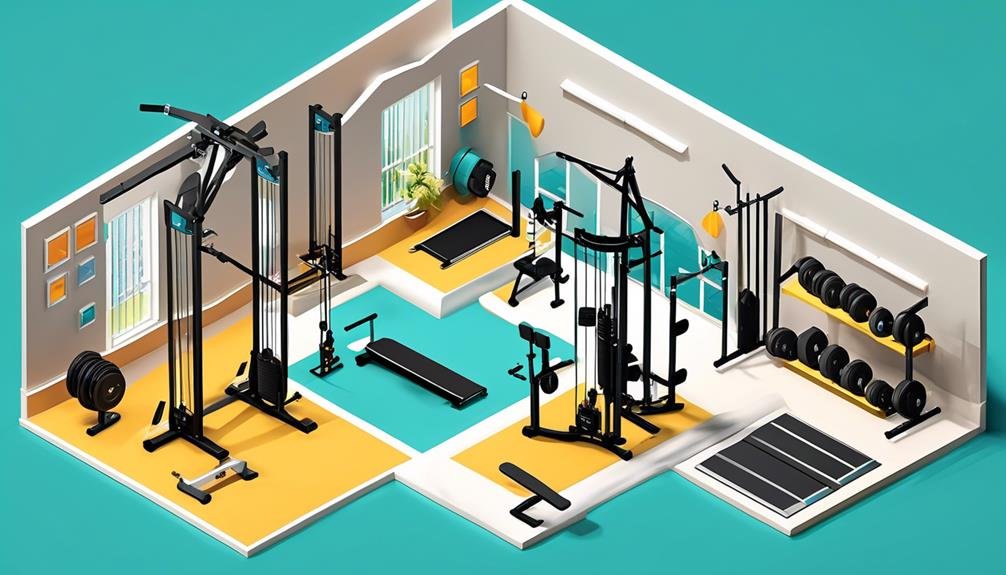Disclaimer: This content is for informational purposes only and does not replace professional medical advice, diagnosis, or treatment. Always consult a qualified healthcare provider before beginning any new exercise program.
As you step onto the treadmill, you find yourself faced with a multitude of settings and options, each promising to help you achieve optimal fat burning. But where do you begin? How do you navigate through the sea of buttons and dials to ensure that your workout is truly effective?
Fear not, for in this discussion, we will guide you through the process of adjusting the settings on a treadmill for optimal fat burning. From finding the perfect speed and incline to incorporating interval training, we will unravel the secrets to maximizing your calorie burn and achieving your fitness goals.
So, prepare to embark on a journey of discovery and unlock the potential of your treadmill workouts.
Key Takeaways
- Gradually increase treadmill speed and incline to avoid injury and effectively burn more calories.
- Incorporate high-intensity interval training (HIIT) with incline walking to enhance calorie burn and improve endurance.
- Find the ideal duration for fat-burning based on individual fitness level and gradually increase intensity.
- Monitor heart rate and adjust treadmill settings to keep it within the fat-burning zone for optimal results.
Adjusting Treadmill Speed
Do you want to maximize fat-burning during your treadmill workout? Adjusting the speed of the treadmill can help you achieve your goals.
Increasing the speed of your treadmill can result in a more effective workout, leading to increased calorie burn and the potential for greater weight loss.
One way to incorporate speed adjustments into your treadmill workout is through intervals. Intervals involve alternating periods of high intensity and lower intensity. By increasing the speed during the high-intensity intervals, you can challenge your body and burn more calories. This approach is commonly used in High-Intensity Interval Training (HIIT) treadmill workouts, which have been shown to be highly effective for calorie burn and fat loss.
It is important to note that increasing the speed too quickly or excessively can increase the risk of injury. Start by gradually increasing the speed and monitor how your body responds. Listen to your body and adjust the speed accordingly.
In addition to increasing calorie burn, adjusting the speed of the treadmill can also help to increase the incline. By combining increased speed with higher incline, you can further challenge your muscles and burn more calories. This can contribute to a reduction in body fat and improved weight loss outcomes.
Optimizing Treadmill Incline
To optimize fat burning on a treadmill, adjusting the incline gradually engages your leg muscles and elevates your heart rate for a more effective workout. Walking on an incline not only burns calories but also promotes muscle tone and strength in your lower body muscles. In fact, walking on an incline increases the metabolic cost by up to 113%, making it a great way to reduce weight and improve your fitness level.
Incorporating high-intensity interval training (HIIT) with incline walking can further enhance calorie burn and improve endurance. HIIT involves alternating between short bursts of intense exercise and periods of active recovery. By incorporating HIIT into your incline workouts, you can increase calorie burn by up to 28% and challenge your body in new ways.
To optimize your treadmill incline workouts, start with a 5-minute warm-up at a comfortable pace. Then, adjust the incline and speed to maintain a challenging workout. It's important to properly balance challenging incline intervals with manageable ones and listen to your body to avoid overexertion.
Finding the Ideal Duration for Fat-Burning

Experiment with different durations to find the ideal time for effective fat-burning on the treadmill. The duration of your workout plays a crucial role in maximizing fat loss. While there is no one-size-fits-all answer, there are some general guidelines you can follow.
For steady-state cardio, a duration of 30-45 minutes is often recommended to target fat-burning. This means maintaining a moderate intensity level for an extended period. It allows your body to use stored fat as fuel, leading to increased calorie burn and fat loss.
Alternatively, you can incorporate high-intensity interval training (HIIT) into your treadmill routine. This involves alternating between short bursts of intense exercise and recovery periods. HIIT workouts are shorter in duration, typically lasting 20-30 minutes. They are highly effective for burning calories and increasing overall fitness levels.
It's important to adjust the duration based on your fitness level and gradually increase the intensity over time. This allows your body to adapt and prevents overexertion or injury. Listen to your body and monitor your progress to determine the most effective duration for fat-burning.
To help you understand the impact of different durations on fat loss, here is a table showcasing the calories burned during a 150-pound person's treadmill workout at various speeds and durations:
| Duration (minutes) | Speed (mph) | Calories Burned |
|---|---|---|
| 20 | 3.5 | 134 |
| 30 | 4.0 | 226 |
| 45 | 4.5 | 347 |
| 60 | 5.0 | 467 |
| 75 | 5.5 | 577 |
Incorporating Interval Training on the Treadmill
Incorporate interval training on the treadmill to enhance calorie burn and elevate your fitness level. Here are three key steps to effectively incorporate interval training into your treadmill workouts:
- Warm-up: Begin with a 5-minute warm-up at a comfortable pace with no incline. This prepares your body for the workout ahead and helps prevent injuries.
- Interval Training: Alternate between brisk walking at a 1% incline and a faster pace with a 5% incline. This combination challenges your body and elevates your heart rate, leading to greater calorie burn. Start with shorter intervals and gradually increase the intensity and duration as your fitness level improves.
- Listen to Your Body: It's important to listen to your body and find a balance between challenging intervals and manageable ones. Overexertion can lead to injuries and burnout, so pay attention to your heart rate and adjust the intensity accordingly. If needed, reduce the incline back to 1% and slow down your pace to recover.
Incorporating high-intensity interval training (HIIT) into your treadmill workouts can be particularly effective. HIIT workouts involve short bursts of intense exercise followed by periods of active recovery. This type of aerobic exercise has been shown to burn more calories and improve cardiovascular fitness. Explore various treadmill HIIT workouts that involve interval training and incline adjustments to find the routine that works best for you.
Monitoring Heart Rate for Optimal Fat-Burning

Monitoring your heart rate is essential for optimizing fat-burning during your treadmill workouts. By keeping track of your heart rate, you can ensure that you're working at the right intensity to maximize fat-burning and achieve your fitness goals.
To determine your target heart rate range for fat-burning, you can use the formula 220 minus your age. This will give you an estimate of your maximum heart rate. The fat-burning zone is typically 70-85% of your maximum heart rate. Calculating your target heart rate range based on this zone will help you stay within the optimal range for fat-burning.
During your treadmill routine, make use of the heart rate monitor on the machine or wear a compatible fitness tracker to continually track your heart rate. This will help you stay aware of your heart rate and make adjustments to your treadmill settings as needed.
To keep your heart rate within the fat-burning zone, you can adjust the settings on the treadmill. Increasing the speed or the incline will challenge your leg muscles and increase your heart rate. Pay attention to your Rate of Perceived Exertion (RPE) as well, which is a subjective measure of how hard you feel you're working.
Regularly check your heart rate throughout the session to ensure it stays within the targeted fat-burning zone. This will help you maintain the right intensity and make the most out of your treadmill routine for optimal fat-burning.
Frequently Asked Questions
What Is the Best Treadmill Setting for Fat Loss?
To optimize fat loss on a treadmill, set it to a 1% incline for brisk walking, incorporate HIIT by varying speed and incline, try the 12-3-30 workout, and combine sprints, jogs, and walks with increased incline.
What Is the Best Speed on a Treadmill for Fat Loss?
Set the treadmill speed to a brisk pace of 3.5 mph for optimal fat burning. This helps you burn about 150 calories in 30 minutes. Remember to vary the speed and incline throughout your workout to keep your heart rate up.
How Do I Set up My Treadmill to Lose Weight?
To set up your treadmill for weight loss, adjust the incline to engage lower body muscles and increase calorie burn. Incorporate high-intensity interval training (HIIT) with varying speed and incline settings for optimal fat burning.
Does 12-3-30 Really Work?
Yes, the 12-3-30 workout can be effective for weight loss. Walking on a treadmill set at 12% incline, 3 mph, for 30 minutes engages leg muscles, increases heart rate, and aids in burning fat.
Conclusion
In conclusion, adjusting the settings on a treadmill can be an effective way to optimize fat burning during workouts.
By incorporating incline walking and high-intensity interval training (HIIT), you can increase calorie burn, engage more muscles, and improve cardiovascular health.
It's important to listen to your body, gradually increase intensity, and find a balance between challenging intervals and manageable ones for the best results.
Remember to monitor your heart rate to ensure you're in the optimal fat-burning zone.



